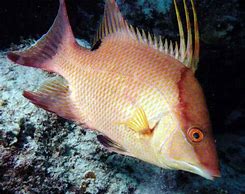
Hogfish
The hogfish is a type of reef fish that belongs to the family Labridae. Here are some interesting facts about hogfish:
Appearance: Hogfish have an elongated body with a slightly compressed shape. They have a large, protruding snout with a pig-like appearance, which gives them their name. Hogfish can vary in coloration depending on their age and sex. Juvenile hogfish have a reddish-brown color with a dark spot on their dorsal fin, while adult males have a vibrant pinkish-red color. Adult females and transitional males have a white or pale gray body with a yellow band across the head.
Size: Hogfish are relatively large reef fish. They can reach lengths of up to 3 feet (90 cm), although most individuals are smaller, typically around 12 to 20 inches (30 to 50 cm) in length.
Distribution: Hogfish are native to the western Atlantic Ocean, ranging from the coast of the United States (Florida, Gulf of Mexico) down to Brazil. They are commonly found in the Caribbean Sea and the Gulf of Mexico, as well as parts of the southeastern United States.
Habitat: Hogfish prefer to inhabit coral reefs, rocky areas, and seagrass beds. They are typically found in shallow waters, ranging from 10 to 100 feet (3 to 30 meters) in depth, although they can occasionally be found in deeper waters. Hogfish are known for their ability to blend into their surroundings, using their coloration to camouflage themselves among coral and rocky structures.
Feeding Habits: Hogfish are carnivorous and have a specialized diet. They primarily feed on small crustaceans, mollusks, and other invertebrates. Their long, protruding snout allows them to search for prey hidden in crevices and burrows on the reef. Hogfish are known for their hunting technique called “hogging,” where they root around in the sand with their snouts to uncover hidden prey.
Life Cycle: Hogfish undergo a unique reproductive process called sequential hermaphroditism. They start their lives as females and transition into males as they grow larger. The largest and most dominant female in a group will become a male and take on the role of breeding with other females. This sex change ensures reproductive success and maintains a balance of males and females within the population.
Conservation Status: Hogfish populations are generally considered stable, but localized declines have been observed in some areas due to overfishing. They are a popular target for recreational and commercial fishing because of their desirable flesh and unique appearance. Regulations and size limits are in place in some regions to help protect and sustain hogfish populations.